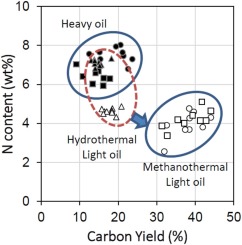The Journal of Supercritical Fluids ( IF 3.4 ) Pub Date : 2019-11-28 , DOI: 10.1016/j.supflu.2019.104704 Fon Yee Han , Masaharu Komiyama , Yoshimitsu Uemura , Nurul Ekmi Rabat

|
Microalgae are promising feedstock for the production of biofuel due to their high productivity and low interference with food production for their cultivation and usage. Owing to their aquatic production environment, however, energy-intensive dewatering and drying processes may be required before their conversion to biofuel. In order to avoid these processes, their liquefaction through hydrothermal means has attracted attention, with extensive research works. The present research proposes and examines alcohothermal liquefaction of wet microalgae, in an attempt to modify and improve microalgae liquefaction characteristics. Thus supercritical methanol was employed as a reaction media for liquefaction of wet Chlorella vulgaris, and the effects of water presence as well as the effects of heterogeneous oxide catalysts were examined. This methanothermal liquefaction gave high bio-oil yield of 54.5 C% (feed microalgae basis) compared to 30.5 C% by hydrothermal for non-catalytic reaction at 385 °C. With Zr(WO4)2 catalyst methanothermal bio-oil yield increased further to 65.6 C%. The presence of water in the methanol medium somewhat decreased the bio-oil yield, while some of the catalysts mitigated the decrease: at 50 wt% water content in methanol, MnO2, ZnO2 and ZrO2 gave bio-oil yield of 55.5 C%, 59.5 C% and 57.6 C%, respectively. Possible mechanism of catalytic methanothermal liquefaction of wet microalgae is discussed.
中文翻译:

超临界甲醇催化湿微藻的醇热液化
微藻由于其高生产率和对种植和使用的食品生产的低干扰而成为生产生物燃料的有前途的原料。但是,由于其水生生产环境,在将其转换为生物燃料之前可能需要进行耗能大量的脱水和干燥过程。为了避免这些过程,其通过水热方式的液化引起了广泛的研究工作,并引起了人们的关注。本研究提出并研究了湿微藻的醇热液化,以试图改善和改善微藻的液化特性。因此,采用超临界甲醇作为湿小球藻液化的反应介质。,考察了水的存在以及非均相氧化物催化剂的影响。该甲烷热液化产生了54.5 C%(以进料微藻为基础)的高生物油产率,而在385°C的非催化反应中,水热法则为30.5 C%。使用Zr(WO 4)2催化剂,甲烷热生物油收率进一步提高到65.6 C%。甲醇介质中水的存在会稍微降低生物油的产率,而某些催化剂可以减轻这种降低:在甲醇中水含量为50 wt%时,MnO 2,ZnO 2和ZrO 2的生物油产率为55.5 C %,59.5 C%和57.6 C%。讨论了湿微藻类催化甲烷热液化的可能机理。











































 京公网安备 11010802027423号
京公网安备 11010802027423号